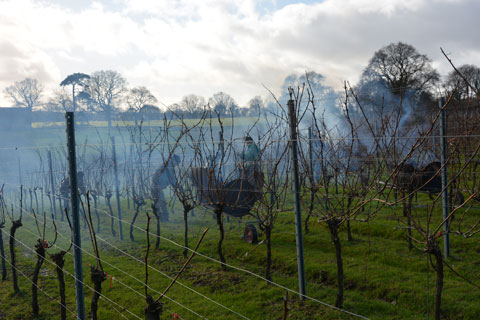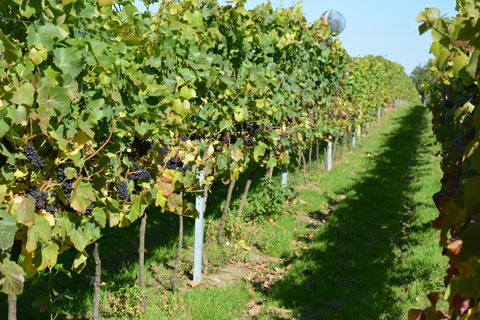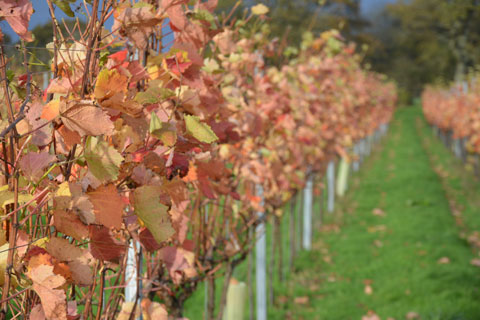In the lea of the South Downs, in Ditchling, East Sussex, Court Gardens Farm has a long history of farming. In Saxon times the farm was known as the Manor of Ditchling Garden, from the middle ages to the reformation it was held by the monks at the priory in Lewes. After a short spell owned by the crown the farm became known as Court Garden. The farm appears on one of the earliest maps of Sussex, Yeakell and Gardner’s map of 1778-1783, just to the north of Ditchling. Not much has changed in the landscape since then.
The vineyard was established in the spring of 2005 on a beautiful south-facing slope with the South Downs as a backdrop, and is now one of the more charming vineyards in England. The family run single-estate vineyard now extends to 17 acres, mainly planted with the three classic varieties of Pinot Noir, Chardonnay and Pinot Meunier for the production of Sparkling Wine, and also Pinot Gris, Ortega, Rondo and Pinot Blanc for use in still wine. Two rare old varieties of Arbanne and Petit Meslier are grown as well.
Sussex shares similar geology to north-east France, the chalk of the downs runs beneath the Channel into France. In East Sussex we have a more maritime climate which is perfect for the production of sparkling wine.
Why not book a tour of the vineyard and winery? Or you can buy Court Garden English Sparkling wines here.
Check the current weather conditions here at Court Garden with our online weather station.
Our Vineyard Year
After the harvest the vines have done their work, the leaves will be changing to golden and red hues. Once there have been a couple of frosty nights the leaves of the vines will fall, the sap will return back to the trunk and roots, and the old canes will lignify. We can now plan for the next year and pruning. Sometimes we can make a start before Christmas, but certainly by January last year’s growth is dormant and the team start pruning the vines. Pruning is the biggest and most important job in the year. The trellising system we use at Court Garden is the Double Guyot method, which is a cane replacement system. Nearly all of last year’s growth above the trunk is pruned away, leaving just two canes to tie down later. It is a skilled job to choose the right canes and the right number of buds to produce a plant which is balanced. We don’t want the vine to try to produce more grapes than it can ripen.
Usually by the end of March the sap is rising and we can finish the job by tying the selected canes down to the fruiting wire.
During April buds are swelling; they begin to burst at the beginning of May and we start to worry about frost. The temperature in the vineyard is monitored throughout the month and candles are lit in the night if the temperature falls below zero. By the end of May the vines have produced a few leaves and we can breathe a sigh of relief.
In June we start bud-rubbing and are looking out for flower spikes. Bud-rubbing removes unwanted shoots from the trunk and, as this is back-breaking work, we often use a giant toothbrush; we even have a mechanical bud-rubber that attaches to the tractor.
By the end of June the inflorescence should be expanding into flowering. Really warm and dry conditions aid the fruit set. By now the vines are putting on a lot of growth and the battle is on to keep them under control by tucking them into the wires on the trellis and mechanically trimming. We trim both the top and the sides, for the most vigorous vines we may have to do this 4 times in the season. If we just left the vines alone the rows would soon join together at the top forming a tunnel!
Regularly spraying to keep any fungal disease in check; mowing the grass between the rows and controlling any weeds amongst the vines keeps us busy through August and September.
In mid August the grapes will start to change colour (this change is known as veraison) and we know we are around 6 weeks from harvest.
By September we are monitoring the sugar and acid levels in the grapes to ensure we harvest at the perfect time. As we approach harvest the sugars will be rising and the acids falling. Our resident kestrels patrol the vineyard, but we also fly hawk kites to discourage the attention of greedy starlings. The grapes are picked by dedicated friends of Court Garden and brought immediately to our modern winery on site. The fruit is gently pressed, beginning its journey to become award-winning wine, using the traditional bottle-fermented method for the production of our sparkling wine.
In November and December our attentions are given to the winery until the leaves are down and we start another year.





